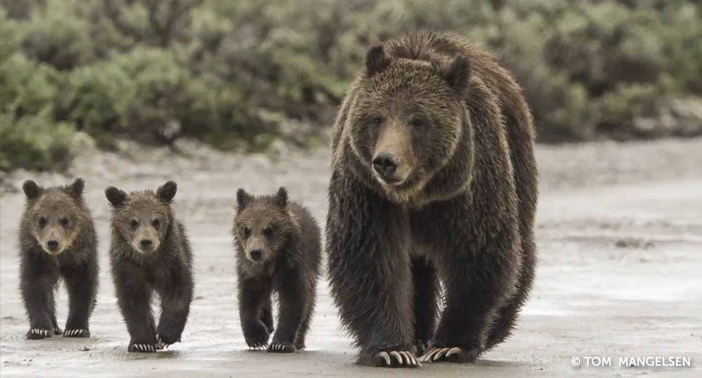Grizzly bears, one of North America’s majestic species of bear, was once hunted to near extinction. Thanks to protections provided under the Endangered Species Act, their populations have been allowed to recover, though they have not yet fully returned across their historic range.
Concerns of food availability, inbreeding and a weakened gene pool, as well as the continued presence of other threats that affect their populations, encourage conservationists to maintain their recommendations that protections remain in place. Despite these recommendations, currently there is a proposal from the U.S. Fish and Wildlife Service to strip these amazing creatures in and arould Yellowstone National Park of the very protections that are helping improve the health of their population.

Photo by Tom Mangelsen from Grizzly: The Story of Mother Grizzly 399 and the Bears of Yellowstone
“Forty years ago when the grizzlies of the Yellowstone ecosystem numbered less than 150 individuals, and their survival seemed precarious, it was thanks to protection under the Endangered Species Act, in 1975, that their number today has risen slowly. But their future isn’t secure yet, because they face so many threats to their survival,” said Jane Goodall, Ph.D., DBE, founder of the Jane Goodall Institute & UN Messenger of Peace in a recent video message (which you can watch above) presented on Capitol Hill in Washington, D.C. In the same video, Dr. Goodall discusses the story of Mother grizzly bear 399, and her three triplets, whom she met with wildlife videographer, Tom Mangelsen in Yellowstone National Park. Dr. Goodall makes this issue very real by helping viewers relate this issue to an individual, and her offspring.
Today, before the official public comment period closes, Dr. Goodall, along with 58 other scientists, submitted an official letter to the Service commenting on their concerns about this proposal and what delisting grizzly bears would mean to their populations. Click here to read the letter.
Read more about this issue here in this interview with two of Dr. Goodall’s close friends, animal behaviorist, Dr. Marc Bekoff and wildlife photographer Tom Mangelsen. Before May 10, you can weigh in with your own public comment on this issue by writing in to the U.S. Fish and Wildlife service. Go to www.regulations.gov and search for FWS–R6–ES–2016–0042. Submit a comment by clicking on “Comment Now!”



